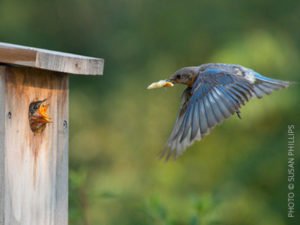NEST BOXES
Setting Up Nest Boxes
BLUEBIRDS AND SWALLOWS
Our Mountain Bluebirds have decided to grace our valley by nesting and working in locations that afford us wonderful looks at these beauties! They spend most of their day eating and feeding insects to their young and are important for insect control. Mountain Bluebirds, like many of our native birds, have declined in recent years. If you have the appropriate habitat, you can help them and receive huge rewards in return. With proper installation, you can have both Mountain Bluebirds and extremely entertaining and gorgeous Tree or Violet-green Swallows. Swallows eat thousands of mosquitos and other insects and can make a huge difference in your outdoor comfort.
Here are a couple plans and tips on where and how to build and install your own boxes.
North American Bluebird Society; Birdwatching-bliss.com; Mountain Bluebird Nestwatch.org
To buy pre-made nest boxes, check out Wild Birds Unlimited at www.wbu.com
Audubon Bluebird House
Whichever plan or ready-made box you choose, take time to investigate to make sure it is properly made. Please make sure it:
Has a predator guard to prevent raccoons, cats or other predators from reaching in to grab nestlings
Is the proper size for our Mountain Bluebirds: 1-9/16″ entry hole and 5”x5” or 5.5”x5.5” at the bottom.
Is well built and watertight with adequate ventilation at the top below the lid. The inside should be untreated wood.
Has either notching grooves or hardwire on the inside below the exit hole so that baby bluebirds can grip the surface and safely leave. A slick surface may prevent them from leaving, and they will die.
Has no perch. Perches encourage predators.
Is installed in an area with an open field or water source nearby and plenty of open space for the birds to fly quickly into their box.
Faces the hole towards the east or southeast. Do not face the hole towards a road where the birds may fly into traffic.
Has a standing snag or other nearby safe perch for birds to sit and guard their nest box is ideal. This also helps the fledglings when they first leave the nest.
Is not placed close to wren nest boxes. House Wrens are very aggressive and will enter the bluebird/swallow boxes and puncture the eggs. Wrens do this to minimize future competition for food. You can locate another wren box far away to eliminate the competition and then enjoy their wonderful (and early) song apart from the swallows and bluebirds.
Is cleaned out in the fall. You can treat them only in the fall with a mixture of thinned linseed.
Is installed well before the breeding season begins. (Best to have ready by mid-April). It can take time for birds to find your boxes, and you may need to wait a couple of years.
Is monitored for signs of wasps, and clean it out right away. They will keep birds from nesting in your box.
Is not installed near an area that uses pesticides or herbicides or has free-roaming cats.
Is attached to a metal or PVC pipe, making sure to seal the opening of the PVC pipe so the birds will not become trapped inside the pipe. Alternatively, use a fence post. Avoid attaching to a tree. Nest boxes should be about five feet high for easy access to clean.
Create a Swallow/Mountain Bluebird Neighborhood
Of the six swallow species in our Roaring Fork Valley, two species commonly nest in boxes: Violet-green and Tree. Both are wonderful additions to your home, school, cemetery, work or neighborhood. Experience has shown that, to increase your chances of attracting the more elusive Mountain Bluebird, you should install two boxes about 15 feet apart. (If you decide to install multiple pairs, put each pair about 300 feet apart.) The swallows will usually not allow another swallow family very close but will allow bluebirds to nest close by (they do not compete for food). This effectively allows more housing in your neighborhood.
If you have any questions or want to share your nest box experiences, contact us!

